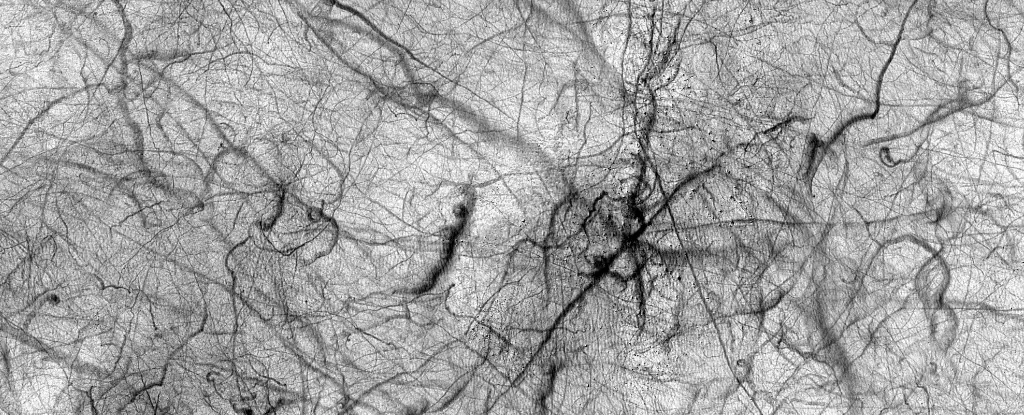NASA’s Mars Reconnaissance Orbiter has once again captivated us with extraordinary imagery. This time, the focus is on the mesmerizing phenomenon of dust devils, which gracefully sweep across the Martian landscape. Captured by the HiRISE camera in September 2022, the image highlights the Haldane Crater, where these swirling whirlwinds are not merely phenomena of beauty, but complex indicators of the planet’s dynamic atmospheric processes. Understanding these marvels offers crucial insights into Mars’s climatic systems, enhancing our comprehension of the planet’s environmental conditions.
The Nature of Martian Dust Devils
Dust devils on Mars are much more than swirling formations; they are a testament to the planet’s atmospheric activity. Created by the rapid heating of the Martian surface, these whirlwinds emerge when warm air rises quickly, generating a rotating column of air that picks up dust particles. Ranging in size from small, insignificant whirls to expansive columns that can measure kilometers across, dust devils can persist for hours. This variability in size and duration adds layers of complexity to their study, revealing the intricate interactions among surface conditions, atmospheric dynamics, and climate on Mars.
On Earth, we recognize tornadoes as destructive forces; on Mars, dust devils exhibit a dual nature. While they can hinder solar power collection by depositing dust on solar panels, they can also serve as natural cleansers, lifting dust away and maintaining the efficiency of vital instruments. This paradox makes dust devils an essential subject of study for scientists and engineers alike, as they can dramatically influence the operational lifespan of robotic missions on the Martian surface.
Mars: The Red Planet’s Unique Atmosphere
Mars, often termed the “Red Planet,” draws its characteristic hue from iron oxide prevalent in its soil. With an atmosphere composed predominantly of carbon dioxide—about 95%—and a trace of nitrogen, argon, and oxygen, Mars experiences an inhospitable climate, averaging temperatures around -60°C. Its thin atmosphere, with only 1% of Earth’s density, poses significant challenges for potential human habitation and any future exploratory missions.
Despite its inhospitable nature, the thin atmosphere enables fascinating weather phenomena like dust devils. These whirlwinds redistribute dust across the planet, influencing not just local weather but also the climate of Mars over time. Each swirl and twist of a dust devil contributes to the broader climatic tapestry of the planet, aiding scientists in developing predictive models for Martian weather.
The geological landscape of Mars is characterized by its dramatic features, including expansive plains, massive volcanoes such as Olympus Mons, and the stunning Valles Marineris canyon system. Evidence suggests that Mars was once home to liquid water and had a much thicker atmosphere, conditions that could have supported past life. The movement of dust, facilitated by dust devils, helps researchers piece together Mars’s geological history.
As dust is lofted into the Martian atmosphere, it can obscure previous geological formations, but it also reveals patterns of erosion, weathering, and sediment deposit. Each dust devil carries with it potential historical data that scientists can analyze to infer changes in the Martian environment. By studying the tracks left behind by these swirling winds, researchers can calculate dust deposition rates, allowing them to build more accurate models of Mars’s climate history.
Dust devils are not just fascinating phenomena; they are also crucial for the planning of future Martian missions. Understanding how dust is moved and distributed across the planet informs mission planners about the challenges spacecraft will face on the surface. Accurate predictions regarding dust accumulation on equipment can enhance the effectiveness of solar panels and extend the operational duration of research vehicles like rovers.
As we push further into our explorations of Mars, the importance of understanding dust devils cannot be overstated. These atmospheric events serve as both a unique aspect of Martian weather and a critical variable in ensuring the sustainability of future explorations. Studying them is not merely an academic endeavor; it is essential for safeguarding the integrity of the technology we send to uncover the secrets of this intriguing world.
The relentless activity of dust devils on Mars illustrates the planet’s dynamic atmosphere and offers profound insights into its environmental processes. As we continue to understand these fascinating whirlwinds, we also deepen our grasp of Mars’s geological and climatic history. The interplay between these dust devils and future exploration underscore the importance of ongoing research and observation, ensuring that as we reach further into the cosmos, we do so with informed strategies and enhanced technological resilience.

